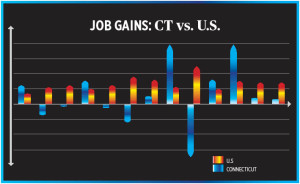Mother Nature likely contributed to what state labor officials described as an anomalous jobs report that saw Connecticut”™s unemployment rate increase one tenth of a point to 8.1 percent in June.
In what would represent a significant reversal of fortunes, private sector employment decreased by 3,200 from May to June while government employment increased by 3,700.
However, an economist for the Connecticut Department of Labor (DOL) said both figures are likely off, citing heavy rains in June that led to a particularly weak month for the construction industry and an extended school year ”” thanks to Hurricane Sandy and winter snowstorms ”” that could”™ve resulted in an extra work week or two for school district and local government employees.
“It”™s obviously a very difficult month to interpret,” said Patrick Flaherty, projecting there would be revisions to the June data. “One of the issues is, of course, the huge drop in the construction industry, which we really think is more a factor of the weather than any sort of weakness in the market.”

Construction industry employment dropped by 1,900, or 3.4 percent, across the state in June after having otherwise posted a strong start to 2013. That, combined with the big jump in local government employment in June, “is not reflective of what”™s actually happening in the economy,” Flaherty said.
Steven P. Lanza, a professor at the University of Connecticut and executive editor of The Connecticut Economy, a quarterly publication on the state”™s economic prospects, said he is not discouraged despite the state adding just 500 nonfarm jobs in June.
Looking at a three-month moving average of job growth, “the trend does show a continued strengthening in Connecticut”™s economy,” Lanza said.
Flaherty said there are likely several thousand ”” and possibly as many as 10,000 ”” more jobs in Connecticut than what has been projected by the DOL.
Among the reasons for the likely undercounting of jobs, Flaherty said, is that the monthly business establishment survey used to generate employment estimates is skewed toward larger firms and features a drastically smaller sample size than national jobs data.
“So if there”™s more dynamism in the small business sector, we won”™t necessarily fully capture that in the survey,” Flaherty said. He said the annual benchmarking process, which occurs around February and uses unemployment insurance tax reports that nearly every employer is required to file with the state, would generate a much more accurate employment count.
Even taking that into account, Connecticut still trails the U.S. in its jobs recovery, Flaherty said.
But, said Lanza, “that wasn”™t true at the beginning of the recovery, when Connecticut”™s economy outpaced the U.S. in terms of gaining back jobs.”
The U.S. has recovered about 6.6 million jobs, or 75 percent of the approximately 8.8 million jobs that were lost between the start of the recession in December 2007 and early 2010.
In contrast, Connecticut has recovered about 58,700 positions, or 48.4 percent of the 121,200 jobs that were lost from March 2008 to February 2010, according to the DOL.
Since a slowdown in the state”™s job market that became apparent last spring, “we sort of shifted back into recovery mode,” Lanza said. “The economy had recovered, then it was flat, and now it”™s recovery again, it seems.”
Pete Gioia, vice president and economist of the Connecticut Business & Industry Association, noted that while the state added just 500 jobs in June, the unemployment rate is four-tenths of a percentage point lower than it was in June 2012.
“I think what we”™re seeing right now is sustainable job growth, but at a slow rate,” Gioia said in a podcast. “And in addition, most of the areas of the state saw job gains.”
The Bridgeport-Stamford labor market area, which comprises the southern portion of Fairfield County, had a strong month, with employment increasing by 3,000 positions compared with May and 6,000 positions compared with June 2012. Employment in the Danbury labor market area dropped by 100 in June, but was up by 700 for the year.
NOTE: An earlier version of this article appeared online July 19.
















